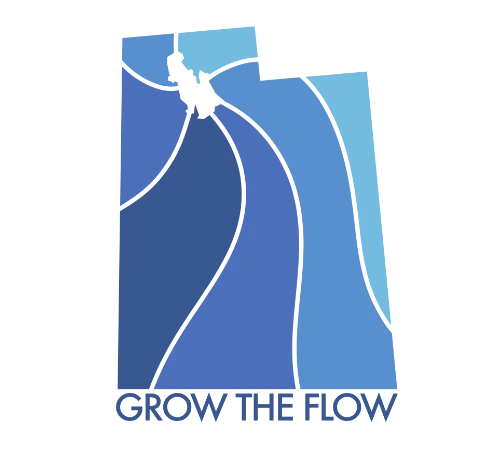I’m guessing you have heard of Grow the Flow because you are reading this right now. If not, we are a movement dedicated to getting more water to the Great Salt Lake! So, what about Slow the Flow? While the names may be easy to mix up, we are two very different attempts to conserve water across Utah.
Slow the Flow, run by the Department of Water Resources, provides consumers with comprehensive ways to lower their indoor and outdoor water use. While some of these tips are helpful—like reusing cooking water for your plants—they will not make a significant difference in how much water you save. However, there are other valuable tools available to significantly decrease your water waste and help lower the state’s municipal water demand.
Since 2022, the state has committed upwards of $10 million to a rebate program, which offers participants up to $3 per square foot when they replace their grass with water-efficient landscaping. In some cases, this program subsidized up to two-thirds of the cost of conversion. With subsidized pricing and immense water savings, this is a cost efficient program that will save you thousands of gallons of water and lower your monthly bill.
Another effective water saving tool is checking for leaks and optimizing the efficiency of your outdoor watering system, which will literally save you tons of water. Slow the Flow offers free water checks, where an expert will spend approximately an hour assessing your sprinkler system efficiency and watering needs based on grass and soil type, local precipitation, and water pressure. Although this may seem menial, a BYU study has shown that over half of Utahns overwater their landscapes.
This state led initiative is a valuable way to educate users and lower our municipal water use as a state. If we decrease municipal water use, Utah’s growing population can continue to thrive using the current water supply despite increases in demand. While this will not provide much water directly to the Great Salt Lake, it will help us avoid the disastrous Bear River Development that would unnecessarily divert 220,000 acre-feet of water from the Great Salt Lake for Wasatch Front residents.
Slow the Flow will not save the Great Salt Lake, but it can help educate our community on the importance of water conservation at all levels. That said, this program must occur alongside a complete shift in the way community members, industries, legislators, and farmers think about how we use water in Utah.
Grow the Flow applauds any and all efforts dedicated to conserving water throughout the state, while also recognizing there is work to do.
The Great Salt Lake needs an additional one-million acre-feet of water each year to avoid ecological collapse, and this water will not come from municipal conservation alone. The consequences of not getting this additional water to the Lake—from the toxic dust to the decimation of the Pacific flyway—are too great a risk for all beings in Salt Lake Valley.
We must act for the Great Salt Lake and the future of our state.
As Utah’s most pressing environmental threat—with a small window of opportunity—it will take creative solutions and collaboration on an unprecedented scale to bring back the Great Salt Lake. Grow the Flow and countless others are up to the challenge.
